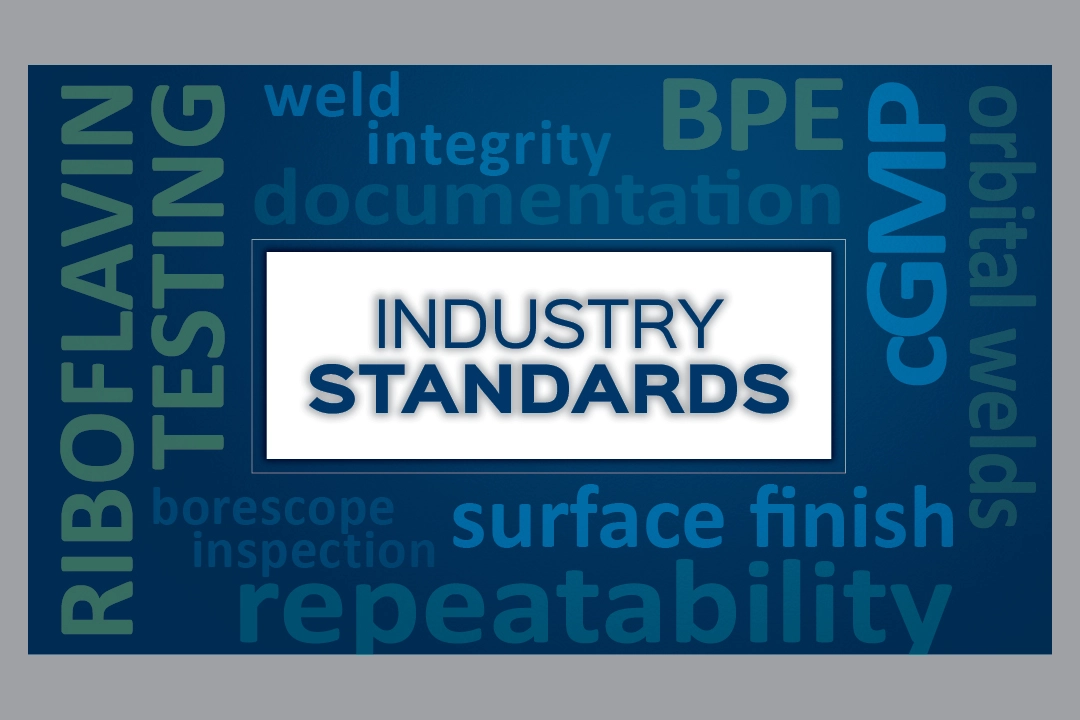Professionals in the bio-pharm industry understand meeting pharmaceutical equipment components requirements is a rigorous task. Close attention to the evolving FDA Current Good Manufacturing Practice (cGMP) regulations and American Society of Mechanical Engineers (ASME) Bioprocessing Equipment (BPE) standards is needed to be in compliance and ensure a hygienic process.
“The BPE standards section for Process Components (SD-3) includes Connections, Fittings and Piping (SD-3.1) and Spray Devices (SD-3.9), which highlight design requirements, Surface Finishes (SD-2.4.4.3), and recommended flow rates for certain vessel sizes and orientations.” Pete Barrie, product manager for Sani-Matic and BPE committee member explained. “These standards guide our design and manufacturing efforts when making spray devices such as directionally drilled spray balls.”
Brian Schaal, lead components designer at Sani-Matic explained how the team creates hygienic components that do not have established standards, “When we receive a pharmaceutical component request that doesn’t have clear industry standards, the requirements are largely determined by the customer and are end-user specific. The rest we extrapolate from established standards based on different systems or equipment such as tanks or cabinet washers.”
Common Features Needed for Pharmaceutical Equipment Components
Many features must be considered in the design and manufacture of hygienic components for pharmaceutical applications:
- Orbital welds. A weld where the welding arc that is mechanically rotated 360⁰ around an object such as a pipe for repeatable results.
- Surface finish or surface roughness. A recommended finish for wetted and non-wetted surfaces.
- Documentation. Turnover packages with required certifications and materials to support cleaning validation efforts.
- BPE fittings. Fittings and tubing are the two categories within the BPE standards that can be BPE certified. All other components listed within the standard may be BPE compliant, but they are not certified.
- Drainability. A design and construction ensuring a slope to drain.
- Material construction. Materials such as 304 or 316L stainless steel.
- USP Class VI certification for elastomers. The USP is an independent, non-profit organization with intent to create high-quality standards for manufacturing and distributing safe and effective medicines, supplements and food. The USP publishes biocompatibility protocols for the plastics and polymers that may encounter human tissue.
- Tri-clamp or weld connections.
It’s all About the Repeatability: The Importance of Orbital Welds
Orbital welds play a critical role in the manufacturing of pharmaceutical equipment components. BPE standards require tubing to be welded using an automated welding process to minimize the possibility of human error and achieve repeatable results.
“It’s all about repeatability,” Scott Norton, certified weld inspector (CWI) and quality inspector for the company said. “An orbital welding system is a computer-controlled welding machine. We have programs set up for various tubing sizes, and the operator selects a program based on size requirements and runs that program. We use previously tested and modified programs for each weld setting so we know that each time a program is run, it is going to be exactly the same – every time.”
“Alignment is also a key factor in orbital welding,” he added. “The orbital needs to be set up so the joint is exactly in line with the tungsten. Once the weld is complete, you have a perfect connection point that doesn’t require additional grinding or polishing at the connection site.”
Norton further explained exactness is required to prevent orbital weld failures that can result in drainability issues, corrosion, and hard-to-clean areas that harbor bacteria. “Any number of reasons could lead to a failed weld,” he explained.
Top Weld Failures and Defect Prevention
- Misalignment. Misalignment of the tubes or other components being welded results in a ridge on the inside of the weld.
- Lack of Fusion. A lack-of-fusion means there isn’t fusion between the weld metal and fusion faces or adjoining weld beads, resulting in a notch effect.
- Incomplete Penetration. Incomplete Penetration is when the weld bead does not entirely penetrate the opposite side of what you are welding. For Sani-Matic, this means the full circumference of the inside diameter (I.D.) of the tubing.
- Discoloration. BPE’s discoloration acceptance criteria for welds states no weld bead shall be discolored.
- I.D. Concavity, also known as “suckback”. I.D. Concavity means that a cave or valley has been created on the inside diameter (I.D.) of the tubing. This can be caused by excessive purge pressure on the I.D. while welding the outer diameter. The purge gas pressure wants to “push” out on the material during the welding process, creating a cave or valley on the I.D. after the weld pool solidifies. Concavity is limited to 10% of the wall thickness by BPE standards.
- Excessive Convexity. Excessive Convexity means that the weld bead on the outside diameter (O.D.) is no longer flush with the base metal. The weld has “sunk” creating a valley on the O.D. Convexity is also limited to 10% of the wall thickness by BPE standards.
- Meandering weld bead. This defect occurs when the weld weaves from side to side in a serpentine pattern rather than continuing in a straight path around the weld joint, which can result in lack of fusion.
- Porosity is pit-type defect that is formed by gas bubbles or air entrapment during solidification.
“If we find any rejected welds, it’s included in the weld log, corrected and re-inspected,” Norton stated.
“The inspection process is incredibly meticulous,” Norton explained. “Each weld receives a sequential number that is detailed in the weld log. It includes information about who welded it, the date, time, joint and both sides’ heat numbers. The heat numbers allow us to trace the full composition of the material used all the way back to the mine. All of that is cross-referenced and documented in the heat map, weld map and weld log, which is further supported by the borescope video recording.”
“Each step in the process provides checks and balances to ensure 100% of the welds have been inspected, approved to meet BPE standards and thoroughly documented,” Barrie added.
Think Inside the Pipe: Borescope Inspections
Each weld is inspected by a Sani-Matic CWI using a borescope. A camera attached to a whip is inserted into the pipe or tube allowing the inspector to see the interior weld. Each weld inspection is video recorded and included within the documentation package.
“The interior weld is the product contact surface in most cases. We’re looking for any pits, cracks, ridges, crevices, scratches, discoloration or other defects outside of the welding acceptance criteria outlined within BPE’s Materials Jointing (MJ) section of the BPE standards,” Norton explained.
Ensuring Clean: Riboflavin Testing
To ensure spray devices are effective, Sani-Matic furthers the inspection process with Riboflavin Testing. This test includes a series of methodical steps performed by a service or engineering team member to document full spray coverage.
To Be Clean, Be Smooth: Surface Finish
The surface finish is an important final step in the fabrication process of pharmaceutical equipment components. Meeting surface finish requirements for a smooth surface decreases the likelihood of soil adhesion and bacterial contamination—and meets hygienic standards for cleanability outlined by BPE.
“At Sani-Matic, the Ra finish, or roughness average, is completed in-house by our grinders. We take the surface finish down to a specific finish reading, which is checked with a profilometer,” explained Schaal. “Typically, the wetted finish of our hygienic components is 15 µin Ra for spray devices and 25 µin Ra for all other components.”
Barrie added that although electropolishing (EP) is not required by BPE, customers may opt for the smooth, mirror-like surface achieved by EP, depending on their process requirements.
Documentation to Support Validation
Upon completion of any system or pharmaceutical equipment components, Sani-Matic’s dedicated documentation specialists compile the necessary turnover packages (Certified As-Built Drawings, Surface Finish Certification, Weld Logs, Slope Maps, Borescope Video Documentation, etc.) required by the customer to validate their cleaning process.
From engineers to certified weld inspectors and documentation specialists, each member of Sani-Matic’s team of experts plays an important role in helping its customers meet the pharmaceutical equipment components requirements.


